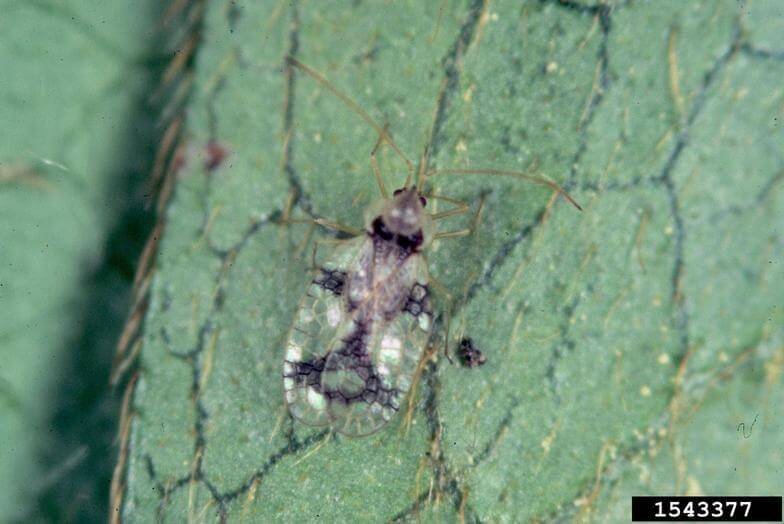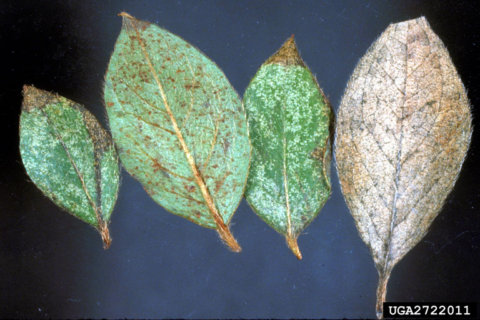
Lace bugs can be a problem, especially on rhododendrons and azaleas. Photo courtesy of Jim Baker, North Carolina State University, bugwood.org.
The weather in the Seattle area this spring has been warmer and drier than normal, creating favorable conditions for lace bugs. So our service techs are seeing lace bugs on shrubs in some of our clients’ landscapes, mainly on rhododendrons and azaleas.
Here are tips on how to manage lace bugs. Taking action in spring will reduce problems in summer.
Lace bugs are a problem in the Pacific Northwest because of our mild climate. Cold weather rarely kills off lace bugs in any of their life stages.

Lace bug damage shows up as yellow dots or stippling on leaves. Photo courtesy of University of Georgia, bugwood.org.
How to tell if you have lace bugs
Look for yellow pinpoints or stippling in the leaves. Heavily damaged leaves appear yellow.
Lace bugs are about 1/8 inch long. They have clear wings with dark blotches in a lacy pattern. Eggs appear as black or brown dots on the underside of leaves. Nymphs look like tiny clear, yellow or black spiky things.
There are several species of lace bugs. The azalea lace bug is more difficult to control than the rhododendron lace bug. It has has multiple generations per year, so it is much more damaging and harder to manage.
How to manage lace bugs
Our recent trend toward hot, dry summers has exacerbated problems with lace bugs. “Studies have shown that drought-stressed plants are much more susceptible to lace-bug attack,” said Ciscoe Morris in the Seattle Times.
1. Keep your plants well watered
Drought-stressed plants are prime targets for lace bugs. Stressed plants often emit distress signals that many damaging insects pick up on.
Water slowly and deeply to reach the entire root zone. Watch our video on how to water to make your plants strong and healthy. And see our list of watering resources below.
According to the American Rhododendron Society, rhododendrons and azaleas are very shallow rooted. They may may dry out in summer, while plants with deeper roots may show no signs of drought stress. Rhododendrons should be well watered during the hot months. This is especially important during the first year after planting.
When watering all plants, be sure to let the soil partially dry out before watering again. Rhododendrons and azaleas ideally grow in damp, never soggy soil. Read more about watering rhododendrons from the American Rhododendron Society and SF Gate Home Guides.
2. Look for and destroy eggs and nymphs in spring
You could use a nontoxic spray such as horticultural oil, insecticidal soap and neem-based products. Coat the leaves well, including on the underside. Repeat regularly. Early season control is very important.
Insecticidal soaps and oils must directly contact the insects to control them. They work best on newly hatched nymphs but can have 80-90 percent control if used correctly. Horticultural oil can also smother the egg stage. “Research from New Jersey has shown a 50 percent reduction of azalea lace bugs after a neem application,” according to Oregon State University.
We don’t recommend using chemical insecticides. They kill important pollinators and beneficial insects that kill other pests.
3. Add plants to encourage beneficial insects
A number of insects eat lace bugs. This includes spiders, green lacewings, earwigs, lady beetles, soldier beetles, assassin bugs, pirate bugs, plant bugs, tree crickets and mites. Research has shown that releasing lacewings among target plants reduces damage from lace bugs.
You can attract green lacewings and other beneficial insects by planting flowering plants such as sweet alyssum, dill, angelica, mallow, fennel, cosmos, cilantro, Queen Anne’s lace, tansy, yarrow, caraway and dandelion. Maintain a wild area in your garden for a natural habitat that will protect and grow populations of beneficial insects. Here are more plants that attract beneficial insects.
4. Call us: we can help you manage lace bugs
We use M-Pede to reduce populations. This product is made from a fatty acid. It’s safe and has limited effects on beneficial insects. We start monitoring for lace bugs in our clients’ landscapes in spring because nymphs are easier to kill than adults. Contact us if you are interested in an application.
Our natural tree and shrub care program can also help. We use compost tea, micronutrients and other products to build the health of soil and plants. A healthy plant will better resist insects and diseases.
5. Apply mulch or compost to beds
Mulch keeps moisture in the soil and prevents shrubs from drying out. It is best to apply mulch in early spring when the soil is cool and damp. You can still add mulch now if you water deeply before applying mulch. Use a thick layer of mulch to reduce both water needs and weeds. Remember to keep several inches of space between the mulch and the plant stem.
6. Don’t over-fertilize
According to the American Rhododendron Society, in fertile soils rhododendrons and azaleas do not need to be fertilized. in less-fertile soils you can apply a complete fertilizer designed for acid-loving plants in late winter or early spring. But use only the amounts recommended for rhododendrons and azaleas. These plants do not need as much fertilizer as other plants. Too much fertilizer may damage roots and leaves or even kill the plant.
7. Move azaleas and rhododendrons to shadier areas if possible
Most rhodies and azaleas prefer shady conditions, so sun stresses the plant. Plants growing in full sun are nearly twice as likely to get infested as those growing in partial shade. It also dries them out more quickly.
8. Consider replacing the plant

Choosing a resistant plant will make it easier to manage lace bugs. ‘Autumn Twist’ is a resistant azalea.
Decide how important your plant is to you and how much you want to do to manage the problem. You may choose to replace problem plants with something that takes less work to look good and stay healthy.
Some azaleas show resistance to azalea lace bug. Here are lists of resistant varieties from Oregon State University and The Azalean.
You might prefer another type of shade-tolerant flowering shrub. Some options include native Oregon grape, red flowering currant, exotic kalmia, hydrangea, osmanthus and daphne.
A diverse or more complex landscape may have fewer lace bug problems, according to NC State Extension.
More info on how to manage lace bugs
- Azalea lace bugs are even peskier than the familiar rhododendron ones, Ciscoe Morris, Seattle Times.
- Azalea Lace Bug: Biology and management in commercial nurseries and landscapes, Oregon State University.
- Azalea lace bug, Oregon Metro.
- Azaleas, rhododendrons face severe threat from lace bugs, The Oregonian.
- Bugs & blights: lace bugs, Sharon Collman, WSU Cooperative Snohomish County Extension.
- Plant Culture and Care, American Rhododendron Society (links to pages on fertilizing, watering, transplanting and more).
- Pests of Landscape Trees and Shrubs, an Integrated Pest Management Guide. 2016. UC Publication 3359.
More info on how to water for healthy plants
Our YouTube playlist on Watering Your Lawn and Garden has several videos on the basics of watering, watering systems, watering new plants and trees, and more.
We have written several blog posts about watering.
- Smart watering: how much, when and how long to water.
- Plants need water to survive and thrive.
- Invest in watering for landscape dividends.
- Choose drought-tolerant plants and reduce time you spend watering.
- Summer lawn care: watering, mowing.
The Saving Water Partnership has information on watering systems and other watering tips.
Swanson’s Nursery has a good article on best watering practices.

My azaleas are infected with Lace Bugs. I thought I had them under control in 2023 using Acephate spray. In 2024 I broke my leg and didn’t do any spraying. The Azaleas are again heavily infected. I have 8 large ever blooming plants ( 30″ high) that are about 13 years old. Should I remove them?
Thank you,
Hi David, we are seeing more lacebug outbreaks on many plants, especially azaleas.
We are finding most affected plants are also suffering from one or more of the following conditions:
–Lack of watering. Unwatered plants are less able to withstand outbreaks. Azaleas have a root mat, they do not have deep tap roots. The plants are susceptible to underwatering because of this.
–Not enough of a mulch layer. All plants need a layer of organic matter covering the soil surface. Mulch helps protect root zones and moderates the soil temperatures. Since azaleas have shallow root zones, a good layer of mulch (not covering the plant’s crown) protecting the roots will help the plant immensely.
–Plants in full sun when they are better off being protected by the canopies of larger plants. Our summers are longer and hotter now, and some plants that were ok in full sun in the past are suffering. Azaleas prefer dappled and/or morning sun and protection from the afternoon heat and full sun exposure.
–Relocation is also an option if there is an acceptable location to move them to.
–Removal is an option if the plants are suffering a lot or have severe damage. There are many plants that do great in our area that can be substituted for the azaleas, and the new plants will not have the same problems.